9 Benefits of Employee Surveys

Company executives don’t always fully appreciate the importance of surveys for employee engagement, well-being, and retention. This means it isn’t always easy to secure their buy-in for corporate listening initiatives.
Sounds familiar?
If so, this article explores a range of employee survey benefits, backed up with research, that you can use to support your proposals. We also share tips on how to pitch them. To increase your chances of getting the green light.
Employee survey types
To provide comprehensive insights, your corporate listening strategy needs various survey types.
These include:
- Satisfaction surveys: assess how content your employees are with aspects like career opportunities, team dynamics, or compensation.
- Engagement surveys: help improve productivity by making employees feel valued and motivated.
- Opinion surveys: used to understand how employees feel about their roles and companies.
- Wellness surveys: focus on such aspects as work-life balance and mental and physical health.
- Onboarding surveys: evaluate how well the onboarding process prepares new hires.
- Pulse surveys: short and sweet, used to quickly gather insights on a particular aspect of employee experience, for example, to evaluate the impact of a policy change.
9 employee survey benefits
So how exactly can employee surveys benefit your company? Here are 9 of the key ways!
1. Informed decision-making
Ever wondered how some companies seem to always make the right decisions?
They’re great at extracting actionable insights from data.
And employee surveys can provide such insights. By regularly surveying your employees, you gather essential data on their needs, concerns, and expectations.
This information allows you to:
➔ Understand the challenges your employees face and address them proactively.
➔ Prioritize decisions that will have the most significant impact on your team’s productivity and satisfaction.
➔ Use the insights to align your business strategies with employee expectations.
Take this question from our employee benefits survey as an example.
At EMBRACE 2024, an event for HR professionals, Lea Lonsted of Mercer, talked about the discrepancies between the benefits the employees want and the companies actually provide. For example, employees would most want companies to prioritize their well-being, but for employers, this was just priority #6.
The responses to the question could help you bridge such gaps.

2. Improved communication and trust
Open and honest communication is the backbone of a healthy and efficient workplace. According to McKinsey, good communication can improve productivity by up to 25%.
Surveys help you:
➔ Encourage employees to share their thoughts and ideas freely.
➔ Uncover areas where employees feel there is a lack of information and improve communication strategy across all channels.
➔ Use feedback to create a more inclusive and collaborative work environment.
For example, one of our clients, Pari, has found that many of its German-speaking staff, especially those working in production, felt excluded because of English terminology used by the company’s leadership. The company acted swiftly to address the issue by incorporating more German terms into internal communications.
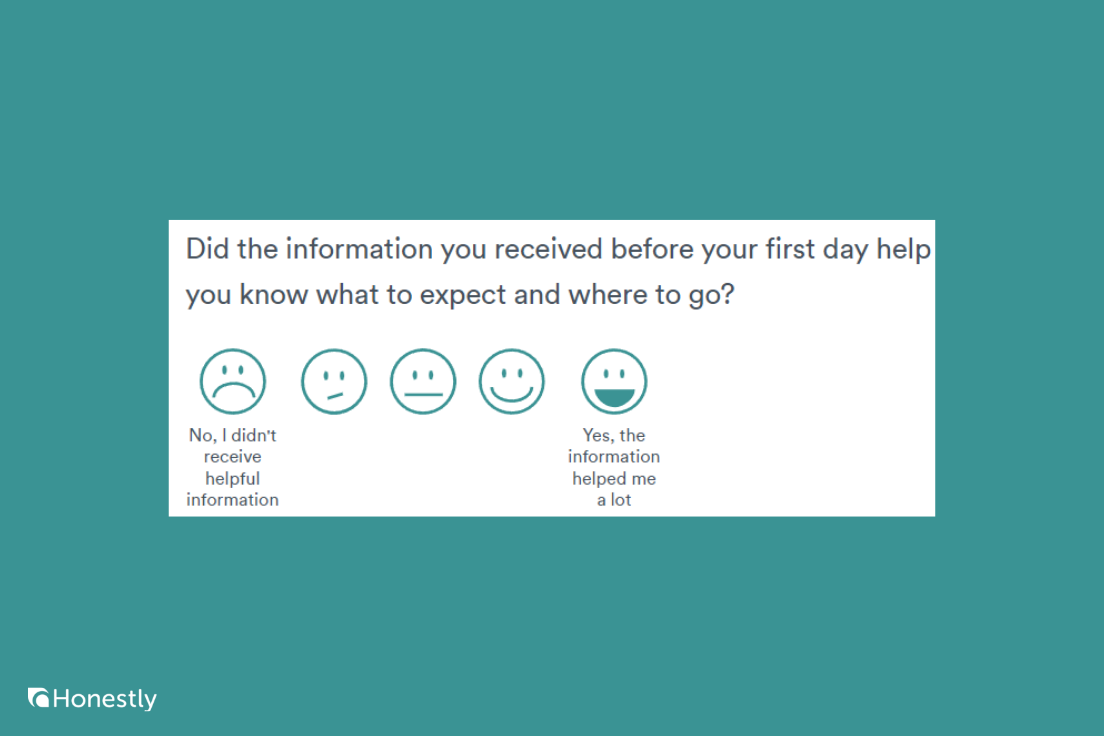
This question from our onboarding survey assessing the effectiveness of communication at the early stages of the employee lifecycle.
It doesn’t stop there.
Employee surveys are a powerful tool to foster transparency and build trust within your organization.
A 2023 study by Achievers Workforce Institute has found that employees who see their company listen to and act on their feedback are 75% more likely to trust their leaders.
3. Higher staff competence
Employee development is vital for maintaining a competitive edge. Surveys can reveal gaps in knowledge and skills. By identifying these gaps early, you can:
➔ Provide targeted training and development opportunities.
➔ Equip employees with the tools they need to excel in their roles.
➔ Foster a culture of continuous learning and professional development.
➔ Inform your hiring processes.
“One of our surveys showed that some of our team members needed to brush up on their Excel skills. So we set up some training sessions which made everyone feel more confident and improved our efficiency. Another survey pointed out that we needed to get everyone up to speed on new insurance regulations. We brought in experts to run workshops, making sure our team was well-informed and capable”.
Rhett Stubbendeck, CEO at Leverage Planning
It gets better:
94% of employees would be ready to stay at their current workplace if they offered better continuous professional development (CPD) opportunities and 83% of HR employees find growth opportunities are essential to attract new staff. So well-designed training programs help you attract and retain staff.

4. Better retention
6-9x of the employee’s monthly pay. That’s the cost of employee turnover rate, according to SHRM.
Recruitment costs, disruption to daily operations, missed opportunities. All this adds up. Long-term business success may be hard to achieve if you can’t retain your employees, especially the most talented ones.
Employee surveys can help you improve retention by:
➔ Identifying why employees leave and addressing those issues.
➔ Fostering a work environment where employees feel valued and engaged.
➔ Implementing policies and practices that keep your best employees from looking elsewhere, like your benefit offerings (or growth opportunities mentioned above).
Here’s an example of an exit survey question that can help you identify employee churn triggers.
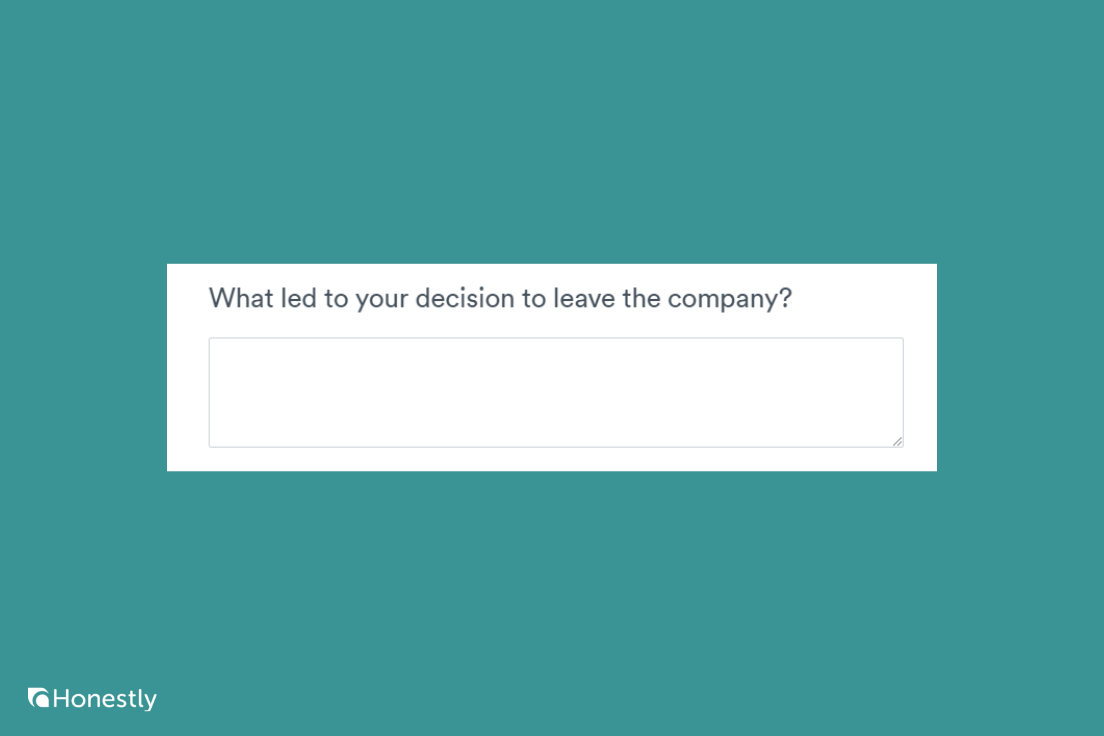
Don’t wait for employees to start leaving en masse. Or quiet-quitting.
Regularly analyze survey responses for signals indicating dissatisfaction and disengagement. And address them proactively before things reach the point of no return.
5. Stronger employee loyalty
Retention is closely linked to employee loyalty. But loyal employees aren’t just less likely to leave. They’re also more engaged, productive, and willing to go above and beyond in their roles.
Surveys can strengthen loyalty by signaling to your employees that you care about their well-being and success. And by helping you assess employee dedication and identify the best ways to increase their commitment.
The catch is that there could be lots of factors that affect loyalty. For example, staff tend to be more 19% productive and engaged if they feel they are rewarded fairly for their work. So you need to draw conclusions from multiple survey questions. Like the one below from our opinion survey.
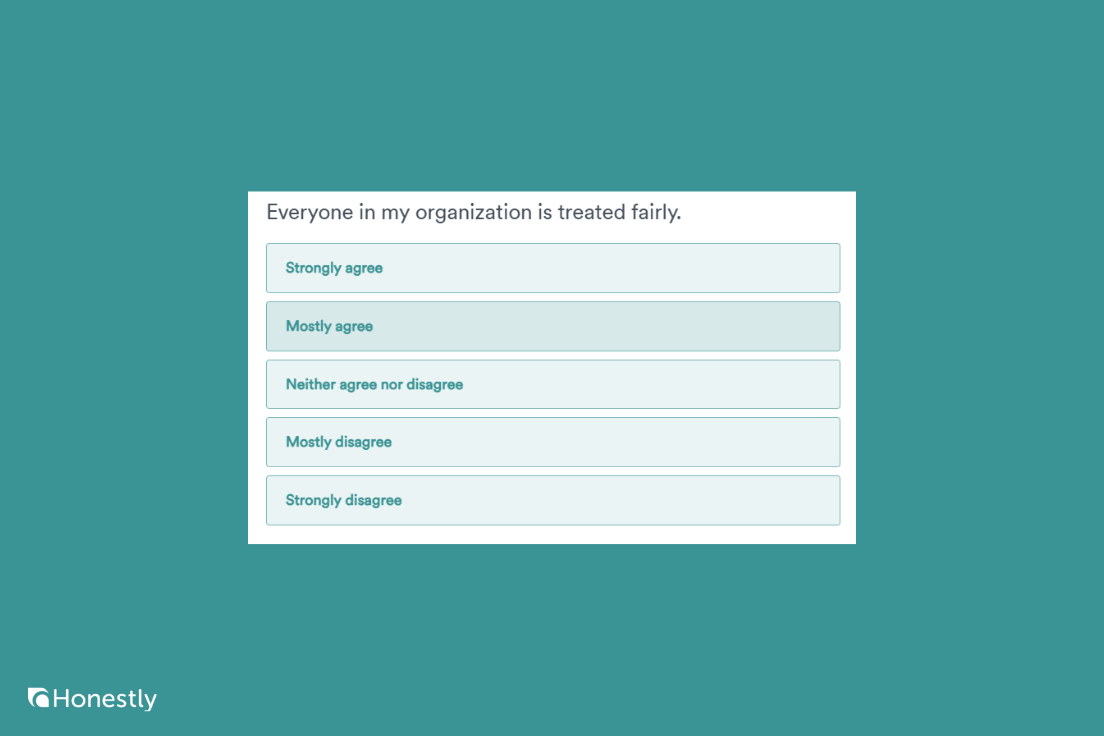
6. Better employee health
Workplace wellness is not just a buzzword - it’s a must. Research shows that poor physical and mental health have an adverse impact on employee performance. For example, stressed employees are less innovative.
Employee surveys can help organizations promote better health by:
➔ Highlighting areas of the workplace that contribute to employee stress and anxiety.
➔ Informing initiatives to support mental well-being.
➔ Evaluating health-related programs and making necessary improvements.
“We began to see a pattern in the feedback about work-life balance. Further analysis of the responses showed that these employees were so much loaded with work that the dividing line began getting blurred between professional and personal life, especially during the remote work shift. It was with this insight that flexible working hours and compulsory “no-meeting” periods were introduced, which helped improve the overall satisfaction level and productivity”.
Lucas Botzen, CEO at Rivermate
What questions can you ask to test it? Here’s one from our wellness survey assessing work-related stress and anxiety.
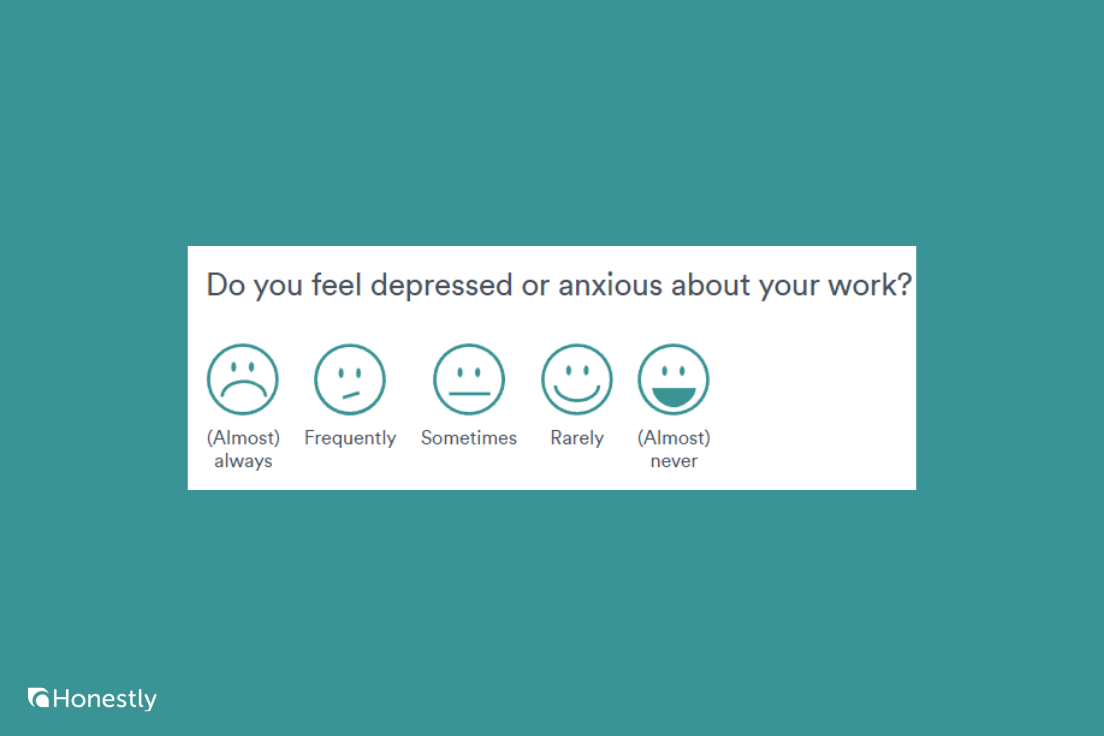
7. Higher employee satisfaction
Did you know?
Satisfied employees are 31% more productive and committed to their work.
Understanding what drives satisfaction is key to maintaining a motivated workforce and that’s where satisfaction surveys come in.
They can help you:
➔ Understand how employees feel about their roles and responsibilities.
➔ Identify factors that contribute to job satisfaction and make improvements.
➔ Recognize and address issues that may be causing dissatisfaction.
Let’s look at the question from our opinion survey as an example:
If a lot of employees don’t feel adequately recognized for their contributions, it’s an indication you need to review how you reward performance. And communicate about it with your employees.
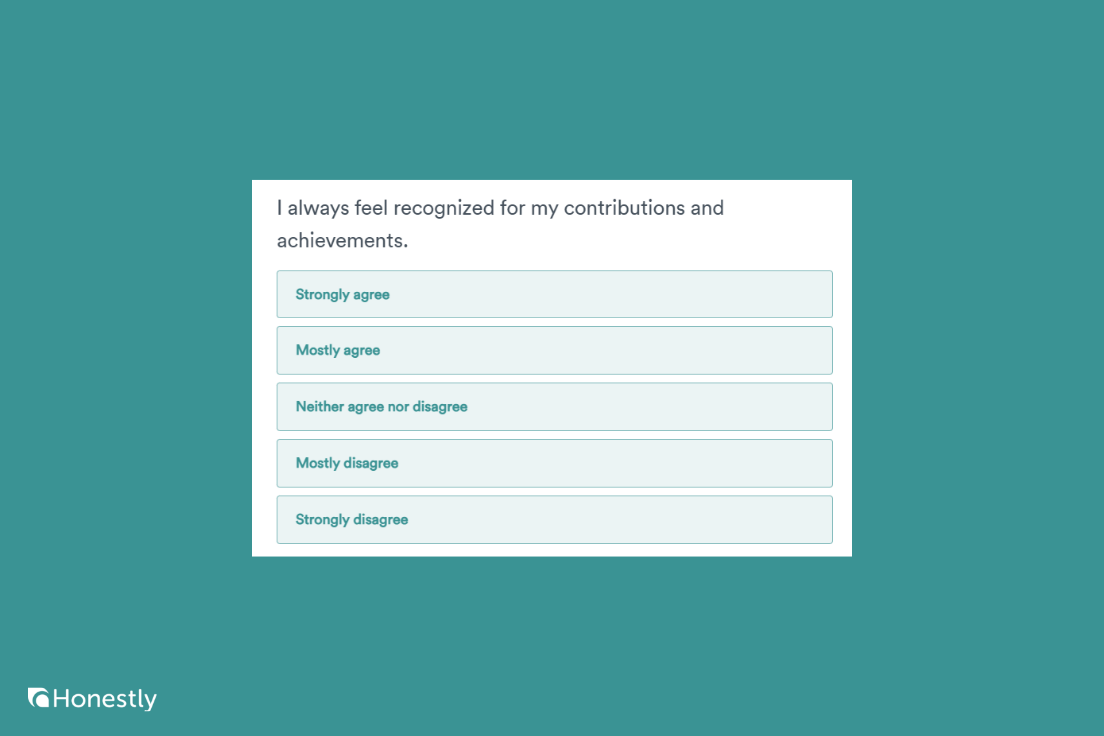
8. Stronger company culture
One of our customers, Helvetia, uses employee surveys to evaluate the strength of its corporate culture:
“We place a strong emphasis on a specific performance culture based on our values of trust, dynamism, and enthusiasm, and our employee surveys are oriented towards these themes. We want to know how well we are living this performance culture and which behaviors we still need to improve”.
Dr. Daniel Bartl, Head of Leadership & Corporate Culture, Helvetia
Employee surveys can help you:
➔ Measure how well employees understand the company’s values and mission. And how well-aligned they are.
➔ Identify gaps between the culture you want to promote and what actually happens on the shop floor.
Here’s a quick question from our opinion survey testing cultural alignment.
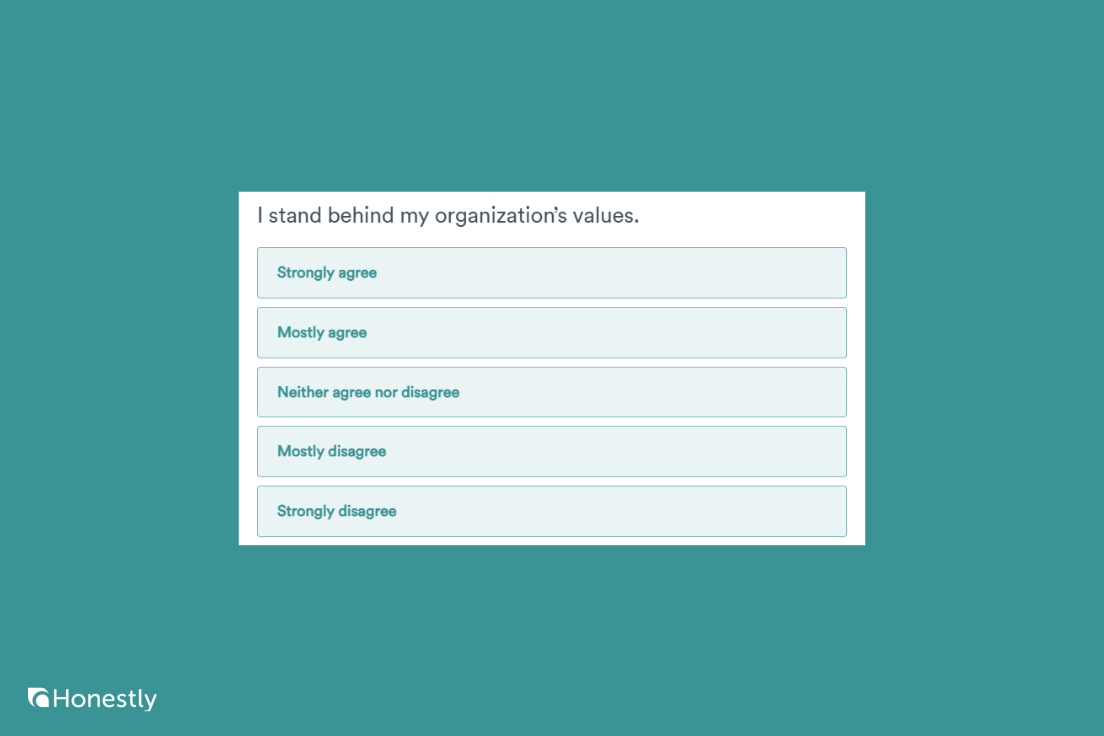
Why does it matter?
Research from Harvard Business Review indicates that organizations with well-developed corporate cultures witness a 400% boost in revenue growth compared to those lacking in cultural strength.
Here’s more:
In the UK and US, 46% of the workforce considers leaving their current positions, citing poor alignment with company values as the main reason.
9. Company performance benchmarking
Understanding how your company measures up against competitors is crucial for continuous improvement.
Employee surveys provide data you can use to:
➔ Compare your company’s performance with others in the same industry.
➔ Recognize where you stand out. And where you need to improve.
Here’s just one reason why you should care:
Exceeding industry standards can help you strengthen your brand reputation, and we know how crucial it is for attracting talent. According to CareerArc, 82% of prospective employees consider the employer brand when applying for posts.
Talking of benchmarking… Did you know that Honestly gives you access to benchmarking data compiled in collaboration with the Free University of Berlin? So that you can compare where you are without sifting through external reports? If you’d like to see it in action, book the demo!
How to pitch your survey strategy
With the benefits of the surveys covered, you’ve got the necessary arguments to support your initiative.
You still need to pitch it to the C-suite execs.
Here are a few tips on how to do it, so that it doesn’t end up at the bottom of the pile.
It’s all about business goals
When preparing your pitch, demonstrate how surveys can help the organization achieve its business goals.
💡Imagine that your company is trying to establish itself as a market leader in your industry, but is lacking the talent and expertise to make this happen. Show them how employee surveys can make your business more attractive to the high-achievers you want onboard.
Conduct cost-analysis
In your pitch, present robust data, for example, from case studies, to illustrate what kind of ROI the company can expect from implementing employee listening strategies.
Don’t focus only on benefits. Show them the cost of inaction as well.
💡For example, if your company suffers from high staff absenteeism or turnover, present tangible data on how much it costs to cover the shifts and recruit new staff.
Integrate with existing programs
Setting up new initiatives can be complex, time-consuming, and costly. Which may not sound particularly appealing if you’ve got lots of other important things on your plate.
You don’t want your project to be seen like this.
To make it more palatable, present your idea not as something brand new but as an extension of existing HR programs. For example, show how surveys can complement and enhance performance reviews, engagement programs, or diversity and inclusion efforts.
Run a pilot
Convincing the C-level execs might be hard if the project requires considerable upfront investment.
The solution?
Propose a pilot survey in one department or team to demonstrate the value without large-scale commitment.
The data and feedback you gather will also help you facilitate a full rollout once it gets the thumbs-up.
Leverage technology
Administering large-scale surveys and analyzing their results may seem excessively complex. Combined with compliance concerns, for example, about data privacy, this can sway the leaders against your case.
Alleviate their concerns by showing how the available survey tools can streamline the process and address the challenges
For example, Honestly offers advanced survey analytics that allows you to track the survey results over time from a single dashboard. And with the AI assistant, analyzing qualitative feedback from open-ended questions is a walk in the park.
Don’t believe me?
Check out how LUSINI managed to simplify survey administration and analysis with Honestly.
And thanks to integrations with various HRMS/HRIS tools like Personio, you can easily keep the employee data synced across your systems.
Final thoughts
As an HR professional, you totally appreciate the impact of a comprehensive corporate listening strategy on business success. But the decision-makers may not.
Convincing them to invest is easier if you have solid data to support your ideas and can demonstrate how they will help the organization achieve its goals.
If you’d like to find out more about various survey types and how to embed them into your HR strategy, why not check out our Employee Survey 101 guide?

